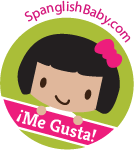
Editor’s note: This guest post was written by Samantha R. Vamos, author of The Cazuela That The Farm Maiden Stirred. It is part of a week-long virtual book tour which ends today. For more information about the book, the author, the illustrator and more chances to enter the giveaway, please visit the rest of the blogs in the tour:
Monday, February 28th – The Latin Baby Book Club
Tuesday, March 1st – The Tiki Tiki Blog
Wednesday, March 2nd – La Bloga
Thursday, March 3rd – Mama Latina Tips
How a Non-Latina Ended Up Writing Bilingual Children’s Books
Although I am not Latina, I have written two bilingual books utilizing Spanish. I am often asked how that transpired and the answer is a combination of my background and the subject matter of my first book, Before You Were Here, Mi Amor (Viking, 2009, illustrated by Santiago Cohen).
In 1998, I wrote a manuscript titled “Before You Were Here” about all the things one family does to welcome a new child into the world. I sold the manuscript to a William Morrow imprint (an imprint is a publishing house division that has a distinct brand name). HarperCollins, however, acquired William Morrow and my manuscript was back-listed with no date for publication. Ultimately and fortunately, I received a release, permitting me to shop the manuscript again.
Five years later, I signed with my current literary agency, Andrea Brown Literary Agency, Inc., and at some point, my children’s literary agent asked if I had any bilingual manuscripts. It was then that I realized that my original English manuscript about a family might appeal if rewritten to incorporate Spanish. I knew that la familia, which includes both the nuclear and the extended family, is the most important social unit in Hispanic or Latino culture, and is similarly significant with my multicultural family. Second, I felt that the story, which evokes the warmth and community of family life, would appeal to readers where children are greatly valued and desired, and the concept of family is held in high regard.
As I incorporated Spanish words, the text resonated more with me because the bilingual manner of speaking reminded me of the way I had heard language spoken as a child. I am first-generation American. During my childhood, while with my father’s family, foreign words from different languages were regularly interspersed with English. I became accustomed to that manner of multilingual speech, but more than that, I liked hearing languages. Entwined as one, two languages seemed to me far more rich and textured. As a child, I always wanted to speak a second language – I imagined it would be my secret language to converse with my sister or family – something special only we shared. As an adult, I know that words from these multiple languages connect me to my family and my diverse heritage. They trigger memories and images and I love that.
When I finished adding the Spanish words, the story seemed to flow differently – the words sounded more intimate, more beautiful and tender. I drew upon the Latin/Hispanic cultural elements to write the book as well as the community and characteristics of my immediate and extended family.
So “Before You Were Here” became Before You Were Here, Mi Amor and Viking acquired it in 2006, publishing it in 2009. Several years before 2006, however, with what I’ve affectionately termed “bilingual on the brain,” I was inspired to write my second, bilingual children’s picture book, The Cazuela That the Farm Maiden Stirred.
A “This Is The House That Jack Built” cumulative format (where the action builds as certain words repeat) had creeped into my mind, and fortunately, wouldn’t let go. I enjoyed saying the refrain, “That went into the cazuela that the farm maiden stirred” and it was so much fun to build upon that chorus.
Here is one of my favorite passages (I’m absolutely WILD about Rafael López’s artwork. I truly love every page and painting, but the hat-wearing-duck/pato first made me laugh out loud and has captured my heart!). My son likes it if I recite the entire book as quickly as I can. We laugh as the momentum builds and each time I begin a new passage I have to take a break and catch my breath. After I read it all once, he typically, enthusiastically says, “Go again, Mom!” How can I say no to that?
“This is the duck
that went to the market
to buy the sugar
to flavor the leche
made fresh by the vaca
while teaching the cabra
that churned the crema
to make the mantequilla
that went into the cazuela that the farm maiden stirred.”
My books are primarily English with Spanish words woven in. There are many more Spanish words in Before You Were Here, Mi Amor than in The Cazuela That The Farm Maiden Stirred in part because the salient words in The Cazuela That The Farm Maiden Stirred repeat. I believe that this bilingual manner of writing demonstrates a value for both languages and I think that’s important for bilingual readers.
Completing the manuscripts was a personal turning point for me because it was then that I became certain that I would introduce Spanish to my future baby. It was a natural fit. When my son was born, I was writing more bilingual work and audibly playing with words and sentences before him, who naturally absorbed language so rapidly. I spoke and read to him all the time. I wanted to enrich his brain as much as I could and teaching him Spanish just made the most sense to me. We lived in Chicago, where he was born, and Spanish was prevalent (as are many languages in a city that size), easy to learn, pronounce, and sounded beautiful. One day when I was trying to explain something to my son, I offered as many words as I could think of to describe an item, utilizing both English and Spanish. The value of having that many more words was not only evident, but also wonderful to me. I began thinking about children, who were introduced to a second language at an early age, and read some research about boosting a child’s brain skills. I found the information so compelling that I posted a link on my website about the cognitive benefits of introducing a second language. The literature on the enhancement of a bilingual brain’s density is stunning; studies state that bilingual brains have an advantage in various abilities and skills (concept formation, reasoning, verbal abilities, etc.) and literally have more neurons for language processing. I think learning a second language can also give children an inherent appreciation for another culture, related traditions, and diversity in general and that is a gift unto itself. I am still learning Spanish, but my son and I are learning together and it is something he and I share in our brains and hearts.
THE GIVEAWAY
Samantha Vamos has offered 3 autographed copies to be given away to 3 lucky readers. The winners will be chosen from all of the comments left on ALL of the blogs.
You have until Sunday night, March 6th, at 11:59 pm PST to leave a comment on one or all of the blogs. (In other words, you can get up to 5 chances to win by leaving a comment on each blog!) To enter this giveaway here, please let us know why you’d like to win a copy of this book.
The winners will be chosen via Random.org on Monday morning and notified via email.




I would like to win this copy because I need to immerse my three year old in more Spanish books. We don’t have enough!
Dear Roxana and SpanglishBaby – Thank you so much for hosting me here today. I have enjoyed being part of this virtual blog tour and this wonderful community of bilingual writers, readers, and families. It’s an honor. All best, Samantha
I want to win a copy of this book because again I am trying to have my girls be bilingual. I’m always game for picking up something in Spanish here or there! Thanks!
We want to win this book because we love spanish! We love reading as family! and we love the story and illustrations!
I want to win this book because my daughter is in a dual-immersion program and can not get enough of the reading! She loves it!
I’d like to win this book because it sounds awesome and my son would love it!
I would like a copy because I am about 5 weeks away from having my first baby and I can’t wait to read with him in English and Spanish!
This would be a great book to add to my son’s collection…as I try to encourage him to stay bilingual…………what a great book to begin with. Maria
Oh pick me. Yo quiero ganar! I would love to add this to our collection. I am always looking for ways to increase my little girls Spanish vocabulary. Plus she loves books.
Hola! I would love to win this book for my girls… We have always been a bilingual household I know mis hijas would adore this beautiful book!
Oh, I’m always looking to making my kids’ bilingual library bigger! Más libros con español , si!
I’d like to win!
The illustrations are brilliant and what a fun idea for a children’s book! I loved that rhyme growing up. Definitely a great and fun challenge for bilingual readers. Can’t wait to check it out! =)
Me, me, pick me!!! What a beautifully illustrated, great story line, bilingual book. I speak Spanish, but it is not my 1st language. My husband speaks English (all the time), but Spanish is his 1st language! I’m the main person in our house teaching my son and this book would be so helpful not to mention a great addition to our books we read on a nightly basis.
Tara